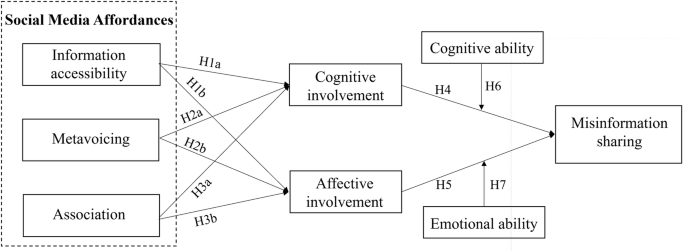The Interplay of Information, Technology, and Human Behavior in the Digital Age
The digital age has ushered in an era of unprecedented information access and exchange, transforming how individuals interact, learn, and conduct business. This interconnected world, facilitated by social media and online platforms, presents both immense opportunities and significant challenges. From fostering organizational innovation through enhanced information literacy to grappling with the spread of misinformation and fake news, understanding the complex interplay between information, technology, and human behavior is paramount. This article explores key themes emerging from recent research on these topics, focusing on the impact of information literacy, the dynamics of misinformation sharing, the role of technology affordances, and the influence of flow experiences in online environments.
Information Literacy as a Driver of Innovation
A study by Ahmad, Widén, and Huvila (2020) highlights the crucial role of workplace information literacy in driving organizational innovation. Information literacy empowers individuals to effectively locate, evaluate, and utilize information, fostering a culture of knowledge sharing and informed decision-making. This, in turn, can lead to the development of new products, services, and processes, ultimately enhancing organizational competitiveness. In today’s rapidly evolving information landscape, equipping employees with the necessary skills to navigate and critically assess information is essential for organizations seeking to thrive.
The Spread of Misinformation and Its Underlying Factors
The proliferation of misinformation, particularly in the context of social media, poses a significant threat to informed public discourse and decision-making. Research by Ahmed (2021) examines the factors contributing to the inadvertent sharing of deepfakes, revealing the influence of political interest, cognitive ability, and social network size. Similarly, Apuke and Omar (2021) investigate the predictors of fake news sharing during the COVID-19 pandemic, emphasizing the role of social media usage patterns and individual susceptibility to misinformation. Bermes (2021) further explores the impact of information overload and transactional stress on fake news sharing, highlighting the mitigating role of consumer resilience. These studies underscore the need for comprehensive strategies to combat the spread of misinformation, including media literacy initiatives, fact-checking mechanisms, and platform accountability.
Technology Affordances and Their Influence on Online Behavior
Technology affordances, the perceived action possibilities offered by a technology, play a crucial role in shaping online behavior. Research has explored the impact of various affordances, such as visibility, editability, persistence, and association (Treem & Leonardi, 2013), on online knowledge sharing (Majchrzak et al., 2013), social tie formation (Dong & Wang, 2018), and self-disclosure (Zhang et al., 2019). Understanding how these affordances influence user behavior is essential for designing effective online platforms and interventions, promoting positive online interactions, and mitigating potential risks. For instance, the affordances of social media platforms can be leveraged to facilitate health information exchange (Wu et al., 2024) and provide online social support (Lin & Kishore, 2021), but they can also be exploited to spread misinformation and engage in cyberharassment (Lowry et al., 2019).
Flow Experiences and User Engagement in Digital Environments
The concept of flow, a state of deep immersion and focused attention, has been extensively studied in the context of online interactions. Chang (2013) examined the role of flow experience in continuing social network game usage, while Finneran and Zhang (2003) explored the antecedents of flow in computer-mediated environments. More recent research has investigated the impact of flow on social media usage and its implications for shopping behavior (Hyun et al., 2022), as well as the buffering effect of flow on the relationship between information overload and social media discontinuance intentions (Lin et al., 2020). Understanding the factors that contribute to flow experiences can inform the design of engaging and immersive online environments, fostering user satisfaction and continued participation. Studies like Zhao and Wagner (2023) delve into the specific platform dynamics, like on TikTok, and how its features induce flow.
Combating Misinformation and Promoting Information Literacy
Addressing the challenges of misinformation and fostering information literacy requires a multi-faceted approach involving individuals, organizations, and policymakers. Media literacy initiatives, aimed at equipping individuals with the skills to critically evaluate information sources and identify misinformation, are crucial. Fact-checking organizations play a vital role in debunking false claims and providing accurate information. Social media platforms must also take responsibility for combating the spread of misinformation on their platforms, implementing stricter content moderation policies and promoting reliable sources of information. Furthermore, promoting information literacy in the workplace is essential for driving innovation and enhancing organizational performance. By providing employees with the necessary skills and resources to access, evaluate, and utilize information effectively, organizations can foster a culture of knowledge sharing and informed decision-making.
Navigating the Digital Landscape
The digital age presents both unprecedented opportunities and significant challenges. By understanding the complex interplay between information, technology, and human behavior, individuals and organizations can harness the power of the digital world while mitigating its potential risks. Promoting information literacy, combating misinformation, and fostering positive online interactions are essential for navigating the ever-evolving digital landscape and creating a more informed and connected society. Further research is needed to fully understand the evolving dynamics of online behavior and develop effective strategies for addressing the challenges and maximizing the opportunities presented by the digital age. This includes understanding how emotional responses and cognitive biases interact with online content (Craig & Choi, 2024; Moravec et al., 2022; Pennycook & Rand, 2019), as well as exploring the motivations behind information sharing, both positive and negative (Chen & Sin, 2015; Talwar et al., 2019; Deng et al., 2024). By integrating these different perspectives, a more holistic understanding of information behavior in the digital age can be achieved.


